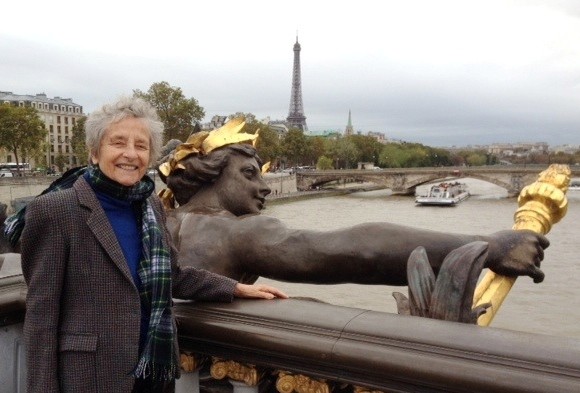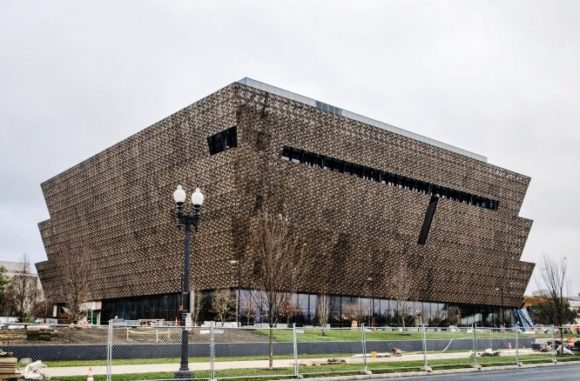
Editor’s Note: Our popular writer from Paris, Nicole Prevost Logan, is back in Essex, CT, for the winter. She does not normally write for us from Essex, but this year, she is making an exception and will be continuing to contribute articles to ValleyNewsNow.com and LymeLine.com during the winter months. Here is her inaugural column from Essex about the opening of a very special museum in Washington DC.
The Grand Opening of the National Museum of African American History and Culture (NMAAHC) will take place in Washington DC this coming Saturday, Sept. 24. The NMAAHC, the 19th and newest of the Smithsonian museums, was established by a bi-partisan Act of Congress in 2003.

The massive structure occupies a prime location next to the Washington Monument and contrasts with the 555 ft. slender obelisk. The dark bronze-colored metal lattice that covers the ‘Corona” also stands out from the white marble classical architecture of most of the other museums standing on the National Mall.
It has been a long struggle for the supporters, such as Congressman John Lewis (D-Georgia), to make the project a reality. They needed to overcome the resistance from several senators who advocated another location. The final approval was more than a triumph — it might be considered a miracle. It succeeded in making a strong statement as to the importance of Black history and culture in the American nation.
The lead designer was David Adjaye, son of a Ghanaian diplomat and the lead architect Philip Freehon, who died in 2009. Founding Director Lonnie B. Bunch III is the visionary and driving force of the project. During some of the many interviews he gave to the press and to a variety of audiences, including select ones like the Aspen institute, he explains the building process and his objective with a very contagious enthusiasm.
The NMAAHC is not intended to be a Holocaust museum, he explains . Its mission is to show the pain but also the joy and the creativity of African-Americans. A daunting fund-raising goal of 450,000 million dollars had to be reached.
The three-tier effect of the construction incorporates elements from African culture, such as the Yoruban crowns from Nigeria. Inside the building, high tech designs and the enormity of the space will make it possible to be versatile in organizing several exhibits simultaneously.
The collections had to be created from zero. It required a treasure hunt into the attics, trunks and basements of the population. To date 35,000 artifacts have been collected. A segregated train from outside Chattanooga (TN) was lowered by crane and the museum built around it. All traffic stopped on Constitution Ave. when an oversized truck delivered the control tower from a federal prison.
Artifacts showing the terrible fate of the slaves are very moving. Such is an amulet created by the Lombi tribe in the form of a shackle. More tragic still were the shackles for children.
But fun and the world of entertainment are also present in the displays , such as Louis Armstrong and his trumpet, Lena Horne or Marianne Andersen . The film archives will be essential to build up history, from Harriet Tubman to the human rights movements of the 1950s and 1960s.
According to Washington insiders , the opening of the new museum is the hottest event in a decade. More than 150,000 special tickets have been distributed to dignitaries while long lines of visitors gather at the entrances of the building to purchase tickets for general admission after the opening.
Editor’s Note: This is the opinion of Nicole Prévost Logan.
 About the author: Nicole Prévost Logan divides her time between Essex and Paris, spending summers in the former and winters in the latter. She writes a regular column for us from her Paris home where her topics will include politics, economy, social unrest — mostly in France — but also in other European countries. She also covers a variety of art exhibits and the performing arts in Europe. Logan is the author of ‘Forever on the Road: A Franco-American Family’s Thirty Years in the Foreign Service,’ an autobiography of her life as the wife of an overseas diplomat, who lived in 10 foreign countries on three continents. Her experiences during her foreign service life included being in Lebanon when civil war erupted, excavating a medieval city in Moscow and spending a week under house arrest in Guinea.
About the author: Nicole Prévost Logan divides her time between Essex and Paris, spending summers in the former and winters in the latter. She writes a regular column for us from her Paris home where her topics will include politics, economy, social unrest — mostly in France — but also in other European countries. She also covers a variety of art exhibits and the performing arts in Europe. Logan is the author of ‘Forever on the Road: A Franco-American Family’s Thirty Years in the Foreign Service,’ an autobiography of her life as the wife of an overseas diplomat, who lived in 10 foreign countries on three continents. Her experiences during her foreign service life included being in Lebanon when civil war erupted, excavating a medieval city in Moscow and spending a week under house arrest in Guinea.